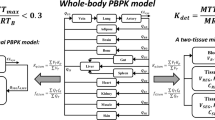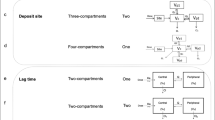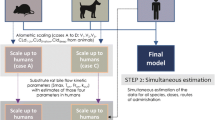Abstract
Non-compartmental analysis of telavancin microdialysis data indicated a sustained exposure in soft tissues and that unbound plasma concentrations were underestimated in vitro. The objective of the present evaluation was to develop a population pharmacokinetic model of telavancin to describe its plasma protein binding, its distribution into muscle, and subcutaneous tissue and to predict pharmacokinetic/-dynamic target attainment (PTA). Total plasma concentrations and microdialysate concentrations (plasma, subcutaneous, and muscle tissue) were available up to 24 h (plasma microdialysate, up to 8 h) post-dose from eight healthy subjects after a single intravenous infusion of 10 mg/kg telavancin. Population pharmacokinetic modeling and simulations were performed using NONMEM. A two-compartment model with saturable protein binding best described plasma concentrations. Plasma unbound fractions at steady state were 23, 15, and 11% at 100, 50, and 10% of the maximum predicted concentrations respectively. Distribution into muscle and subcutaneous tissue was non-linear and described appropriately by one additional compartment each. Based on total plasma concentrations, predicted median (95% confidence interval) values of AUC/MIC (MIC 0.125 mg/L, clinical breakpoint for MRSA) at steady state were 4009 [3421–4619] with a PTA of 96 [78–100] %. The fAUC/MIC in muscle was 496 [227–1232] with a PTA of 100 [98–100] %. The %fT>MIC was approximately 100% in plasma and interstitial space fluid of muscle and subcutaneous tissues up to an MIC of 0.25 mg/L. The model provided a new hypothesis on telavancin plasma protein binding in vivo. Proposed pharmacodynamic targets in plasma and muscle are achieved with currently approved doses of 10 mg/kg daily.





Similar content being viewed by others
References
Akaike H (1974) A new look at the statistical model identification. IEEE Trans Automat Contr 19:716–723. https://doi.org/10.1109/TAC.1974.1100705
Ambrose PG, Drusano GL, Craig WA (2012) In vivo activity of oritavancin in animal infection models and rationale for a new dosing regimen in humans. Clin Infect Dis 54:S220–S228. https://doi.org/10.1093/cid/cis001
Beer J, Wagner CC, Zeitlinger M (2009) Protein binding of antimicrobials: methods for quantification and for investigation of its impact on bacterial killing. AAPS J 11:1–12. https://doi.org/10.1208/s12248-008-9072-1
Brill MJE, Houwink API, Schmidt S, van Dongen EPA, Hazebroek EJ, van Ramshorst B, Deneer VH, Mouton JW, Knibbe CAJ (2014) Reduced subcutaneous tissue distribution of cefazolin in morbidly obese versus non-obese patients determined using clinical microdialysis. J Antimicrob Chemother 69:715–723. https://doi.org/10.1093/jac/dkt444
EUCAST (2014) Consultation on proposed EUCAST telavancin breakpoint changes. http://www.eucast.org/eucast_news/news_singleview/?tx_ttnews[tt_news]=114&cHash=edb6bd58f7a3d341fdc937a3f1679359
Hegde SS, Reyes N, Wiens T, Vanasse N, Skinner R, McCullough J, Kaniga K, Pace J, Thomas R, Shaw JP, Obedencio G, Judice JK (2004) Pharmacodynamics of telavancin (TD-6424), a novel bactericidal agent, against gram-positive bacteria. Antimicrob Agents Chemother 48:3043–3050. https://doi.org/10.1128/AAC.48.8.3043-3050.2004
Higgins DL, Chang R, Debabov DV, Leung J, Wu T, Krause KM, Sandvik E, Hubbard JM, Kaniga K, Schmidt DE, Gao Q, Cass RT, Karr DE, Benton BM, Humphrey PP (2005) Telavancin, a multifunctional lipoglycopeptide, disrupts both cell wall synthesis and cell membrane integrity in methicillin-resistant Staphylococcus aureus. Antimicrob Agents Chemother 49:1127–1134. https://doi.org/10.1128/AAC.49.3.1127-1134.2005
Kim A, Suecof LA, Sutherland CA, Gao L, Kuti JL, Nicolau DP (2008) In vivo microdialysis study of the penetration of daptomycin into soft tissues in diabetic versus healthy volunteers. Antimicrob Agents Chemother 52:3941–3946. https://doi.org/10.1128/AAC.00589-08
Krekels EHJ, van Hasselt JGC, Tibboel D, Danhof M, Knibbe CAJ (2011) Systematic evaluation of the descriptive and predictive performance of paediatric morphine population models. Pharm Res 28:797–811. https://doi.org/10.1007/s11095-010-0333-1
Lepak AJ, Zhao M, Andes DR (2017) Comparative pharmacodynamics of telavancin and vancomycin in the neutropenic murine thigh and lung infection models against Staphylococcus aureus. Antimicrob Agents Chemother 61:e00281–e00217. https://doi.org/10.1128/AAC.00281-17
Lodise T, Patel N, Hedge S, et al (2010) Mouse thigh MRSA infection model data and mathematical modelling to determine telavancin dosing for complicated skin and skin structure infection trials. In: Eur Congr Clin Microbiol Infect Dis. Blackwell Publishing, Vienna
Lodise TP, Butterfield JM, Hegde SS, Samara E, Barriere SL (2012) Telavancin pharmacokinetics and pharmacodynamics in patients with complicated skin and skin structure infections and various degrees of renal function. Antimicrob Agents Chemother 56:2062–2066. https://doi.org/10.1128/AAC.00383-11
Lodise TP, Gotfried M, Barriere S, Drusano GL (2008) Telavancin penetration into human epithelial lining fluid determined by population pharmacokinetic modeling and Monte Carlo simulation. Antimicrob Agents Chemother 52:2300–2304. https://doi.org/10.1128/AAC.01110-07
Matzneller P, Österreicher Z, Reiter B, Lackner E, Stimpfl T, Zeitlinger M (2016) Tissue pharmacokinetics of telavancin in healthy volunteers: a microdialysis study. J Antimicrob Chemother 71:3179–3184. https://doi.org/10.1093/jac/dkw269
Post TM, Freijer JI, Ploeger BA, Danhof M (2008) Extensions to the visual predictive check to facilitate model performance evaluation. J Pharmacokinet Pharmacodyn 35:185–202. https://doi.org/10.1007/s10928-007-9081-1
Samara E, Shaw J-P, Barriere SL, Wong SL, Worboys P (2012) Population pharmacokinetics of telavancin in healthy subjects and patients with infections. Antimicrob Agents Chemother 56:2067–2073. https://doi.org/10.1128/AAC.05915-11
Savic RM, Karlsson MO (2009) Importance of shrinkage in empirical bayes estimates for diagnostics: problems and solutions. AAPS J 11:558–569. https://doi.org/10.1208/s12248-009-9133-0
Schaeftlein A, Minichmayr IK, Kloft C (2014) Population pharmacokinetics meets microdialysis: benefits, pitfalls and necessities of new analysis approaches for human microdialysis data. Eur J Pharm Sci 57:68–73. https://doi.org/10.1016/j.ejps.2013.11.004
Shaw JP, Seroogy J, Kaniga K, Higgins DL, Kitt M, Barriere S (2005) Pharmacokinetics, serum inhibitory and bactericidal activity, and safety of telavancin in healthy subjects. Antimicrob Agents Chemother 49:195–201. https://doi.org/10.1128/AAC.49.1.195-201.2005
Sun HK, Duchin K, Nightingale CH, Shaw JP, Seroogy J, Nicolau DP (2006) Tissue penetration of telavancin after intravenous administration in healthy subjects. Antimicrob Agents Chemother 50:788–790. https://doi.org/10.1128/AAC.50.2.788-790.2006
Theravance (2016) VIBATIV (telavancin) prescribing information. https://www.vibativ.com/pdf/PrescribingInformation.pdf
Theravance (2008) Telavancin for the treatment of complicated skin and skin structure infections FDA briefing document for anti-infective drugs advisory committee meeting. https://www.fda.gov/ohrms/dockets/ac/08/briefing/2008-4394b2-01-FDA.pdf
Tsuji BT, Leonard SN, Rhomberg PR, Jones RN, Rybak MJ (2008) Evaluation of daptomycin, telavancin, teicoplanin, and vancomycin activity in the presence of albumin or serum. Diagn Microbiol Infect Dis 60:441–444. https://doi.org/10.1016/J.DIAGMICROBIO.2007.11.011
Tunblad K, Hammarlund-Udenaes M, Jonsson EN (2004) An integrated model for the analysis of pharmacokinetic data from microdialysis experiments. Pharm Res 21:1698–1707. https://doi.org/10.1023/B:PHAM.0000041468.00587.c6
Wise R (1983) Protein binding of beta-lactams: the effects on activity and pharmacology particularly tissue penetration. II. Studies in man. J Antimicrob Chemother 12:105–118
Wong SL, Barriere SL, Kitt MM, Goldberg MR (2008) Multiple-dose pharmacokinetics of intravenous telavancin in healthy male and female subjects. J Antimicrob Chemother 62:780–783. https://doi.org/10.1093/jac/dkn273
Worboys PD, Wong SL, Barriere SL (2015) Pharmacokinetics of intravenous telavancin in healthy subjects with varying degrees of renal impairment. Eur J Clin Pharmacol 71:707–714. https://doi.org/10.1007/s00228-015-1847-6
Wright DFB, Duffull SB (2017) A general empirical model for renal drug handling in pharmacokinetic analyses. Br J Clin Pharmacol 83:1869–1872. https://doi.org/10.1111/bcp.13306
Zandvliet A, Copalu W, Schellens JHM et al (2006) Saturable binding of indisulam to plasma proteins and distribution to human erythrocytes. Drug Metab Dispos 34:1041–1046. https://doi.org/10.1124/dmd.105.008326
Author contribution statement
PM and MZ conceived, designed, and conducted the clinical study. SU and MT developed population pharmacokinetic model and performed simulations. MZ and UF supervised the clinical study and population pharmacokinetic analysis respectively. SU wrote initial draft of the manuscript. All authors contributed in and agreed upon the final version of the manuscript.
Funding
Financial support in the form of PhD scholarship of Sami Ullah from the Higher Education Commission, Pakistan, through the German Academic Exchange Service (DAAD) is highly acknowledged. The funders had no role in study design, data collection and interpretation, or the decision to submit the work for publication.
Author information
Authors and Affiliations
Corresponding author
Ethics declarations
Conflict of interest
The authors declare that they have no conflict of interest.
Additional information
Publisher’s note
Springer Nature remains neutral with regard to jurisdictional claims in published maps and institutional affiliations.
Electronic supplementary material
ESM 1
(PDF 754 kb)
Rights and permissions
About this article
Cite this article
Ullah, S., Matzneller, P., Zeitlinger, M. et al. A population pharmacokinetic model of intravenous telavancin in healthy individuals to assess tissue exposure. Naunyn-Schmiedeberg's Arch Pharmacol 392, 1097–1106 (2019). https://doi.org/10.1007/s00210-019-01647-w
Received:
Accepted:
Published:
Issue Date:
DOI: https://doi.org/10.1007/s00210-019-01647-w




